The ARM vs x86 Wars Have Begun: In-Depth Power Analysis of Atom, Krait & Cortex A15
by Anand Lal Shimpi on January 4, 2013 7:32 AM EST- Posted in
- Tablets
- Intel
- Samsung
- Arm
- Cortex A15
- Smartphones
- Mobile
- SoCs
Krait: Idle Power
We'll start out our power investigation looking at behavior at idle. Although battery life when you're actually using your device is very important, having a fast SoC that can quickly complete tasks and race to sleep means that you need to be able to drive down to very low idle power levels to actually benefit from that performance. Here we're looking at power consumption at the Start Screen in Windows RT/8. You'll notice that there are two distinct periods during the benchmark, with the latter part of the graph showing lower power consumption thanks to the live tiles going to sleep. In this test, WiFi is enabled but there's no background syncing of anything. WiFi being on is why we continue to see power spikes even after the live tiles have gone to sleep:
The W510 does a great job of drawing little power at idle. Its silly WiFi implementation results in peak idle power consumption that's very similar to the Dell XPS 10, but the lowest the platform hits is appreciably lower than anything else. Surface RT remains the more power hungry of the three, while the XPS 10 falls somewhere in between MS and Acer.
If we isolate CPU core power alone though, things are a bit different. Keep in mind that we don't have the L2 power island instrumented, so the XPS 10 looks a little better than it should here but minimum CPU power consumption is very good on Krait. Although the Atom Z2760 is built on a special SoC derivative of Intel's 32nm process, I do suspect that it's not quite as low power as TSMC's 28nm LP. Things may change by the time 22nm rolls around however. All meaningful compute transistors here should be power gated, and what we end up looking at is the best case leakage for all SoCs. The Krait/28nm LP combination is awesome. I'm not sure why Tegra 3 is so much more active here towards the very end of the curve by comparison.
Adreno 225, or at least whatever Qualcomm drives off of the GPU power rail is extremely power efficient at idle. The PowerVR SGX 545 curve looks flatter at the end but Qualcomm is able to hit lower minimum power levels. It's not clear to me how much of this is architecture vs. process technology. On the GPU side there is some activity happening here as the display is still being refreshed even though the system is idle, so we're not looking at purely power gated consumption here.
To take the WiFi controller out of the equation, I tossed all tablets into Airplane mode and re-ran the same tests as above. You'll notice much less fluctuation in power consumption once the live tiles go to sleep.
Take WiFi out of the equation and Acer's W510 looks really good. Intel worked very hard with Acer to ensure power consumption was as low as possible on this device. The XPS 10 does a bit better than Surface RT here, but not tremendously so. Acer/Intel hold the clear advantage.
Looking at the CPU power island alone (excluding the L2 cache for Krait), we continue to see lower idle power consumption from APQ8060A vs. Atom Z2760. Once again I believe this is a TSMC 28nm LP advantage more than an architectural thing.


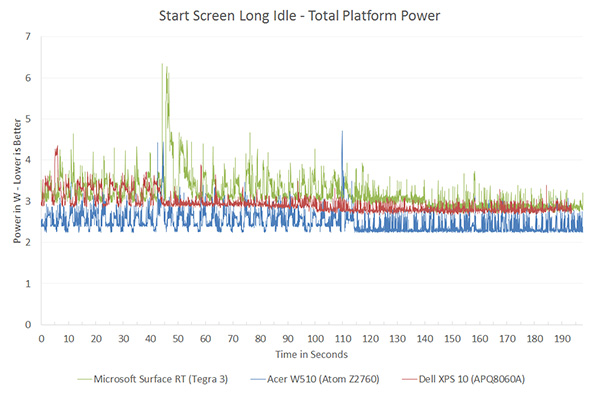
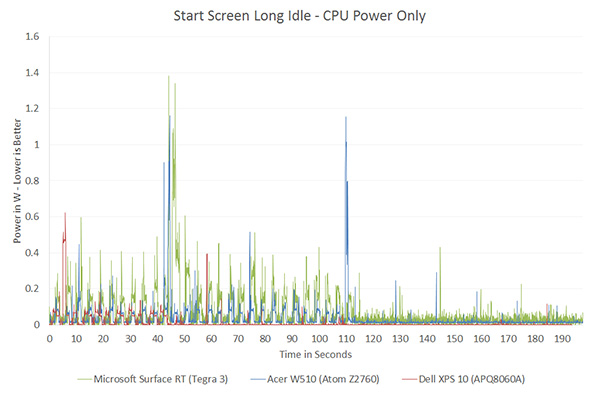
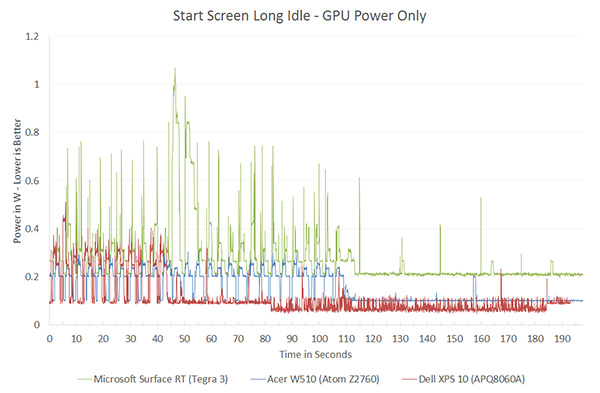
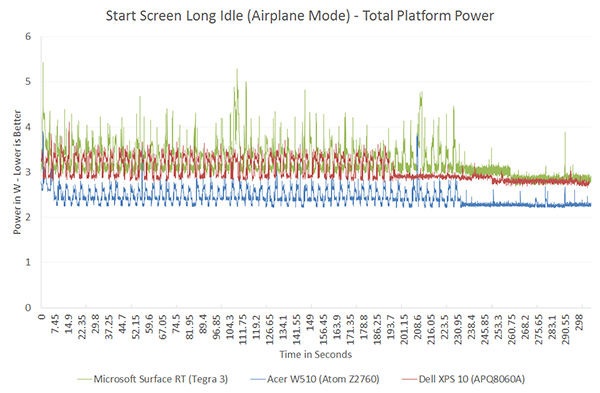
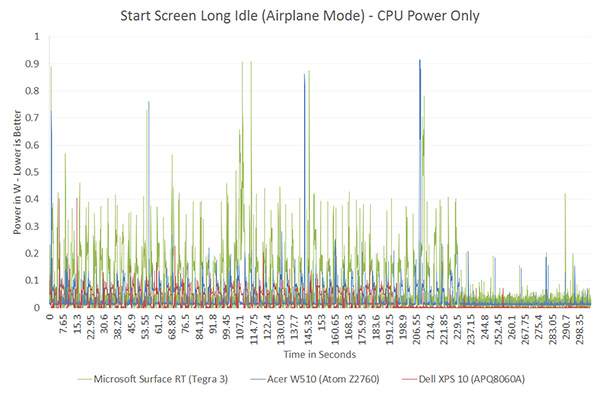
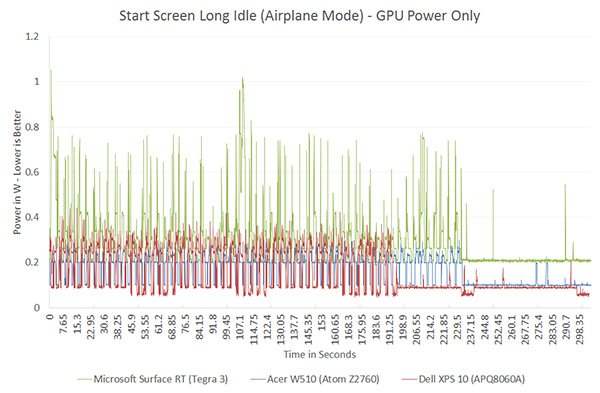








140 Comments
View All Comments
extide - Friday, January 4, 2013 - link
When will you post an article about Bay Trail / Valley View?? Usually you guys are pretty fast to post stuff about topics like this yet I have seen some info on other sites already...jpcy - Friday, January 4, 2013 - link
...which I bet CISC users thought had ended about 18 years ago...It's good to see a resurgence of this highly useful, extremely low-power and very hardy British CPU platform.
I remember back in the day when ARMs were used in the Acorn computers (possibly too long ago for most to remember, now - I still have an A7000 and a RISC PC with both a StrongARM and a DX2-66 lol) was at war with Intel's Pentium CPU range and AMD's K6's, boasting an almost 1:1 ration of MIPS:MHz - Horsepower for your money (something Intel and AMD were severely lacking in, if I remember correctly.)
And now, well, who'dve thought it... These ARM CPUs are now in nearly everything we use... Phones, smartphones, tablets, notebooks...
Suppose I was right in the argument with my mate in school afterall... RISC, superior technology (IMHO) may well take over, yet!
nofumble62 - Friday, January 4, 2013 - link
No performance advantage, no battery life advantage. Why anyone would bother with incompatible software?sseemaku - Friday, January 4, 2013 - link
Looks like people have changed religion from AMD to ARM. Thats what I see from some comments.mugiebahar - Saturday, January 5, 2013 - link
Yeah n no. They wanted a no paid opinions to screw with the outcome. But Intel hype won over real life .Intel better and will get better - yes
Any chance they will compete (performance and PRICE) and legacy. Support to phone apps - Never in the near future which is the only time for them.
tuxRoller - Saturday, January 5, 2013 - link
Also, any chance for an actual performance comparison between the platforms?Apple's performance and power use look awesome. Better than I had imagined.
I'd love to see how they compare on the same tests, however.
Kogies - Saturday, January 5, 2013 - link
It appears the war has begun, well two wars in fact. The one you have articulately described, and the oft ensuing war-of-words...Thanks Anand, I appreciate the analysis you have given. It is excellent to get to see the level of granularity you have been able to achieve with your balance of art and science, and knowing where to hook into! I am very interested to see how the L2 cache power draw effects the comparison, just a little jitter in my mind. If nothing else, it looks as if the delicate balance of process tech., and desired performance/power may have a greater bearing on this "war" than mere ISA.
With Krait 300, Haswell, and more A15's this is going to be a tremendous year. Keep up the good work.
Torrijos - Saturday, January 5, 2013 - link
Any chance we could see the same tests run on the latest Apple iPad?That way we could have a chance to see what Apple tried to improve compared to the A15 generation.
urielshun - Saturday, January 5, 2013 - link
The whole discussion about ARM and x86 is not important when you go for the ecomonics of each platform. ARM is dirty cheap and works well. It's 1/10th of the price of any current Atom with decent perfomace (talking about RK3066).Don't underestimate the Chinese they are having a field day with ARM's pricing model and and have shown amazing chips.
In 8 years from now all SoC's would have reached the usuable performace and the only thing that will matter will be power and cost of integration.
iwod - Saturday, January 5, 2013 - link
Where are you getting 1/10 of a price from? Unless they are produced on good old 40nm LP Node with Nothing else, or crap included, otherwise there just aren't any Chinese SoC selling for $4